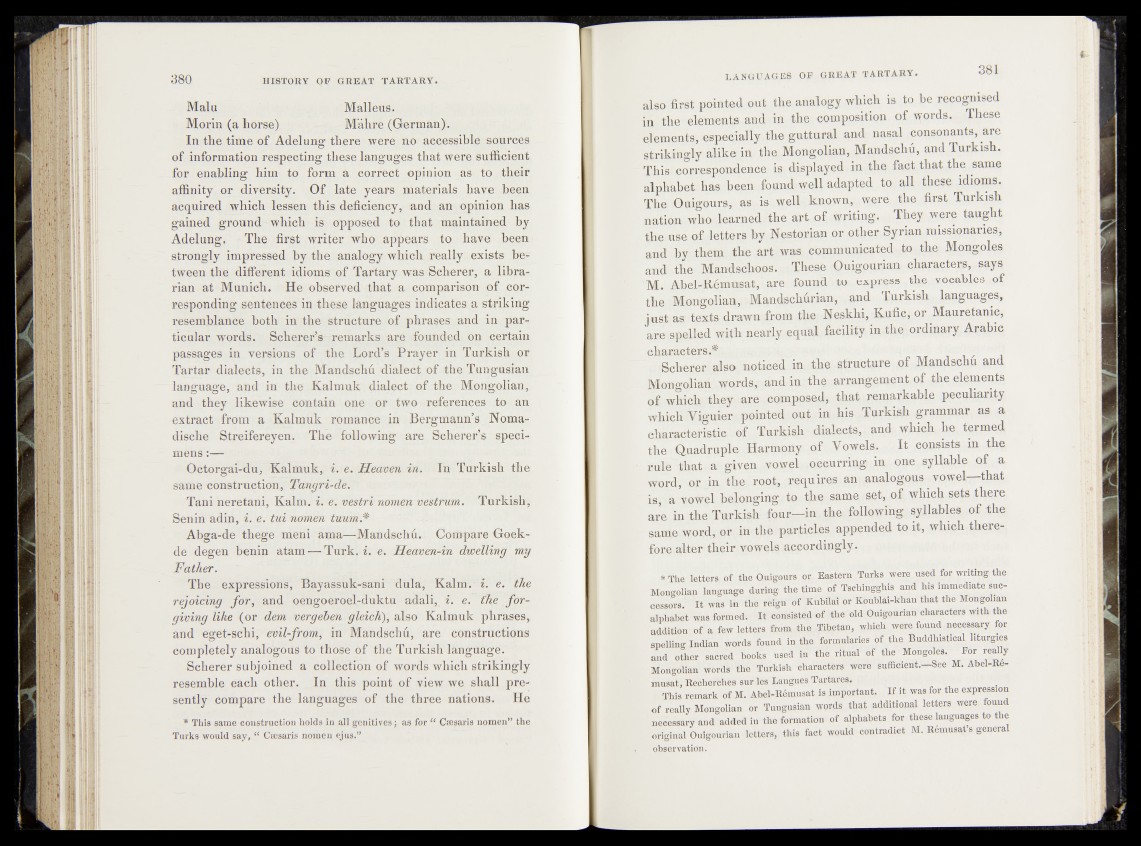
Mala Malleus.
Morin (a hoTsp).. Mahre (German).
In the time of Adelung there were no acces^ibl^sources
of Information respecting1 tbe.se languges that Y^ere sufficient
for enabling him to form a correct opinion as to their
affinity, or diversity. Of late years materials have been
acquired which lessen this deficiency, and an opinion has
gained ground which is opposed to that maintained by
Adelung. * The first writer who appears to r have been •
strongly impressed by the analogy which really, exists be*
tween the different idioms of Tartary was Seherer, a librarian
at Munich. He? observed that a comparison of corresponding
sentences in these languages indicates a striking
resemblance both in the structure of phrases, and in particular
words. Scherer’s- remarks are founded,, op .certain
passages in versions of the Lord’s Prayer in Turkish or
Tartar dialects, in the Mandschu dialect of ,the Tungusian
language, and in the Kalmuk dialect of the Mongolian,
and they likewise contain one- or twO'»ref<^e£^e$3jbPi an
extract from a Kalmuk romance in Bergmann’s Noma-
dische Streifereyen. T h e ‘following are Schaerer’s specimens
:—-
Octorgai-du, Kalmuk, i.-e. Meaven vri.' In Turkish the
same construction, Tangri-de.
Tani |#eretani, Kalm. i.e. vestri nomenvestrum. Turkish-*,'
Sen in adin, ii e.- tui nomen tuum.*
Abga-de thege meni ama—MandsefifiL Corh pare Goek-
de degen benin atam — Turk. i. e. Heaven-in dwelling my
Father.
The expressions, Bayasstik-sani dula, Kalm. i. e. the
rejoicing for, and oengoeroel-duktu adali, i. e. fhe forgiving
like (or dem vergehen gleich), also Kalmuk phrases,
and eget-schi, evil-jrom, in Mandschfi, are constructions
completely analogous to those of the Turkish language.
Bcherer subjoined a collection of words which strikingly
resemble each other. In this point of view we shall presently
compare the languages of the three nations. He
* This same construction holds in all genitives; as for “ Csesaris nomen” the
Turks would say,.“ Csesaris nomen ejus.”
also first pointed out the analogy which is to be reeogmsed
in, the* elements and i inr||hp* composition of words. These
elements; especially *fch,e guttural and nasal consonants, are
Strikingly a l% ^ the Mongolian, Mandschu, and Turkish.
ThisLeorrespondenpe* is displayed,in the fapt that the same
alphab^hasibeemifeund ^qll adapted ta,all these idioms.
The Ouigours, as is well ..known,-.were, the first Turkish
nation who learned/the arlp.of.writing..-.They were taught
thpmsf of getters by T^fStorian or .otbe^Syrian missionaries,
aujL b$ them ,the,art was^pmmunic^ted*tosithe, Mongoles
and the Mandschopsi^^hefte i^uigpprjan characters, says
"M. found to .express .the vocables of
the. - Mongolian, Mands<gaurian, and Turkish languages,
jus.t as; texts drawn from the Neskhi, Kufip^qj, Mauretanic,
are,spelled with nearly equal kicility in the,ordinary Arabic
characters.* . ^ ,
piSchercr also noticed in the structure .of Mandschu and
Mongoliail wo,rds?pand in the .arrangement.,of,the elfpaents
of which they are composed, that ^remarkable peculiarity
which Viguier-fcpointed out in, his Turkish grammar as a
characteristic of Turkish dialecfs^ and which,,he termed,
the Quadruple Harmony of Vowels-. It consists.^ the
rule that> a given vowel, »occurring in one s y lla b le ^ . a
word, or j n tb«yroot, requires an analogous vowel—that
i , a vowel belonging to. tlie same set, qf which sets there
are in the Turkish foupn-in the. following .syllables of the
same word, or in the particles-appended- tout, which.there-
for-e alter their vowels.accordingly.
* The letters of the Ouigours or Eastern Turks weje used for writing the
Mongolian language during the time of Tschingghis and his immediate successors.
1 It was in the reign of _KubilaiorKoublai-khan that the Mongolian
alphabet was formed. It consisted of ’the old Ouigourian characters with the
addition of a few letters from the; Tibetan, which were found necessary for
spelling Indian words found in the formularies of the Buddhistical liturgies
and other sacred books M ^ ' r i t u a l of the Mongoles. really
Mongolian words the Turkish characters were sufficient.—See M. Abel-Re-
musat, Recherches sur les Langues Tartares.
This remark of M. Abel-R6musat is important. If it was for the expression
of really Mongolian or Tungusian words , that additional letters were found
necessary and added in the formation of alphabets for these languages to the
: original Ouigourian letters, this fact would contradict M. Remusat s general
observation.